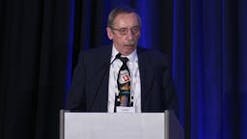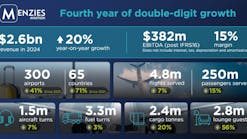A primer on fuel mixture theory
By Richard W. Kamm
I am constantly surprised how unknowledgeable many pilots and aircraft mechanics are concerning fuel air mixtures used in reciprocating aircraft engines. Many fables that never applied continue to be perpetuated by the uninformed. One of my least favorite is that "a lean mixture burns hotter than a rich mixture." As you should learn by the end of this article it all depends on the starting mixture, it can burn hotter, but it also can burn cooler.
Terms To start with we must first define a few terms commonly used when discussing fuel mixtures. Air-fuel ratio The air-fuel (expressed air to fuel) ratio is a weight relationship and can be expressed as a number or a decimal fraction. If given as a volume relationship, the number for air would be very large and would vary with every change in air density and therefore become meaningless. Stoichiometric air-fuel ratio This is a chemical term referring to the exact mixture of air and fuel to completely combust a fuel to water and carbon dioxide. During the combustion process all the fuel and oxygen will be consumed. The stoichiometric mixture only refers to the burning characteristics of the fuel; it has nothing to do with the type of fuel metering system or engine. It varies with the type of fuel used. For gasoline and diesel fuels it is an air-fuel ratio of approximately 14.7 to 1 (fuel to air ratio of 0.067). Engine design can change how much of the available heat is converted to useful energy but it cannot change the chemical characteristics of the fuel. Modern automobiles often run in the stoichiometric range for environmental reasons, but it is of little use in aircraft because it does not result in the greatest power or the greatest economy, however it gives the highest cylinder head temperature.
Best power
Using a typical air-cooled aircraft engine running at normal power, with the throttle in a fixed position, if fuel
is slowly added to the stoichiometric mixture (0.067) the added fuel will have a cooling effect and the combustion gas and cylinder head temperature will decrease. If the engine is equipped with a test club, a fixed pitch propeller or a propeller that can be put into the fixed pitch position, the propeller will act as a dynamometer and engine rpm will be an indication of power. As the mixture is enriched, the power (rpm) will increase until an F/A ratio of approximately 0.074 is reached. From 0.074 to 0.080, the power will remain relatively constant, although combustion temperatures will continue to decrease. As the mixture is further enriched above 0.080, power and combustion temperatures will both decrease. Mixtures from 0.074 to 0.080 are called best power mixtures, as their use results in the greatest power for a given airflow or manifold pressure. For further definition, 0.074 is called lean best power while 0.080 is rich best power. Do not be fooled by the designation lean best power. This is a rich mixture as it is rich of stoichiometric and the mixture is fuel cooled. Because of different induction system or combustion chamber designs the best power
ratios can change slightly between engines but they always retain the same relationship rich of stoichiometric.
Unfortunately, under sea level conditions, best power mixture cannot be used at the highest engine powers. As manifold
pressures are increased above the cruise power range, the combination of the heat of combustion and burning time would cause the mixture to overheat, and detonation would occur. To combat these effects, we enrich the mixture to an air/fuel ratio of approximately 0.100. Although this takes the mixture out of the best power range, it allows the use of higher manifold pressures and an increase in power results.
Best economy
Using the same air-cooled engine under the same normal power conditions as stated earlier, if the mixture is slowly leaned below 0.067 the mixture becomes air-cooled with the mixture temperatures and power both decreasing at an increasingly rapid rate. This loss of power is not necessarily a liability but can be turned into an asset. As the mixture is leaned, a point is reached where the greatest power per unit of fuel is achieved. This greatest power per unit of fuel (the lowest fuel consumption per horsepower) is named the best economy mixture. This mixture range can vary slightly with rpm and other conditions but for a large radial engine it varies between 0.060 and 0.065 with normal ignition, and between 0.055 and 0.061 with the spark advanced (many large radial engines had a method of advancing the spark for better utilization of best economy mixtures). The best economy range can be very useful but its proper use depends upon equal mixture distribution to all cylinders and being able to closely monitor cylinder combustion conditions.
Equal mixture of air distribution was not a major problem with the large radial engines. In their induction system, after passing the throttle, the air enters a centrifugal impeller or supercharger. This raises the pressure and temperature, and gives equal distribution to intake pipes of the same length to each cylinder.
Effects of engine design
Concerning induction systems for other types of engines, even the simplest multi-cylinder engine’s induction system
can, and usually does, give different air/mixture flow to the cylinders. For visual proof, compare the finely tuned resonant induction system of a modern car to an automobile induction system of 25 years ago. These new cars are fuel injected with their induction systems only carrying air, proving by example the difficulty of providing equal air distribution. There is practically no way an aircraft opposed engine with a float carburetor can give equal mixture distribution to every cylinder; therefore these engines have carburetors that must be calibrated to run in the rich best power range. Pressure carburetors and fuel injection systems do provide some improvement, but because of induction system design, unequal mixture distribution still remains a problem. Now don’t go screaming to the engine designers about their negligence, as they have to design an engine that will fit a cowling and cooling system designed by the aircraft manufacturer to produce minimum drag. This gives little option on the location of the fuel metering components. Just imagine the additional aerodynamic drag that would be produced if an opposed engine with an automobile-type resonant
induction system were installed on an aircraft.
For maximum propeller clearance and pilot
forward visibility, most opposed engine intake manifolds are located below the cylinders. This location can also cause mixture problems. Any liquid fuel in the cylinder drops to the bottom of the intake runner and may end up being distributed to other cylinders. This is one reason that many fuel-injected engines have mixture distribution problems. This mal-distribution of mixture is another reason that it is difficult to fully lean most engines.
One designer of fuel metering system components is solving the distribution problem by manufacturing different sizes of fuel metering jets for each cylinder’s fuel injection nozzle. This means that a six-cylinder opposed engine has six different discharge nozzle fuel metering jets, each with its own cylinder location.
Adjusting by fuel color and then with torquemeter
Even prior to World War II the flight engineers of the large trans-ocean flying boats were leaning their engines to best economy mixtures during long-range cruise conditions. Their method was to monitor cylinder head temperatures (CHT) and exhaust gas color at night, adjusting mixtures accordingly. Because CHT reacts relatively slowly to temperature changes, this was a tedious process, particularly when the engine exhaust color could not be seen.
During WWII, most long-range cruise control was accomplished by the use of charts specially prepared for each aircraft and engine combination. After WWII, torquemeters that measured the torque output of large aircraft engines became common. These were used as the primary instrument for adjusting mixtures to the best economy range. The pilot or flight engineer leaned the mixture for a specific torque drop and that would give the best economy mixture.
Lean mixtures burn slower than rich mixtures therefore some engines were fitted with spark advance, usually controlled by the flight engineer, that fired the spark plugs 10 degrees earlier than normal on the compression stroke. This allowed for even leaner mixtures.
More precise mixture control available today
Today there are several graphic engine-monitoring systems available for general aviation aircraft, which make more precise
mixture control available. They allow the pilot of a fuel-injected engine to monitor individual cylinder CHT and EGT (exhaust gas temperature). Some monitoring systems are very compact, with all cylinder conditions displayed on a single instrument. They also usually include built-in systems to warn of any radical change of EGT or CHT..
Analyzing the power curves
To better understand the effects of mixture on engine operation we should study the mixture to power curves produced by the engine manufacturers. These curves produced by many different aircraft reciprocating engine manufacturers all show similar patterns of power and temperatures. The chart used (page 12) is published by Textron Lycoming (Lycoming Flyer Key Reprints 1996 p-37 or Lycoming Service Instruction No. 1094D). It shows the effects of leaning on an engine running at a constant engine rpm and manifold pressure.
Looking at the chart there are a few differences that should be noted. On the chart, the best power range is called the max power range, but in the text and on the left side of the chart, the mixture is referred to as the best power mixture. This is probably because these tests were done on a dynamometer where rpm and manifold pressure could be kept constant despite power changes (which is not true when the engine is mounted on the aircraft). The term max power range could be misleading, as one might mistakenly believe that this mixture could be
used when running the engine at maximum manifold pressures. The chart could also mislead the casual reader into believing that all mixtures to the left of max power cruise are lean and all mixtures to the right of max power cruise are rich.
The cylinder head temperature curve gives the location of the stoichiometric mixture. With no excess fuel or air, stoichiometric mixture is located where the highest CHT occurs. All mixtures to the right of peak CHT are rich mixtures and are fuel-cooled, all mixtures
to the left of peak CHT are lean mixtures and are air-cooled.
EGT curves: Economy and power ranges The exhaust gas temperature curve can be used to give an indication of the best economy and best power ranges. The slower burning characteristics of a lean mixture cause the heat of combustion to continue further into the power stroke and EGT peaks lean of stoichiometric. Once beyond this point even the exhaust gases become air-cooled. As the chart indicates, peak EGT occurs at the rich end of the best economy range. Enriching the mixture to approximately minus 125 degrees Fahrenheit rich of peak EGT will produce best power. Because of the immediate reaction of EGT to mixture variations, it is undoubtedly the best tool available for evaluating mixture on fuel-injected opposed aircraft engines. RPM cannot be used as an indication of power as practically all aircraft equipped with EGT systems have constant speed propellers. The abbreviation TIT stands for turbine inlet temperature on turbocharged engines and is synonymous with EGT on an unsupercharged engine. The percent power curve gives an indication of the power relationship to mixture at a fixed manifold pressure. The highest power for the pressure is produced in the best power range. This is a wide flat range and fuel-metering systems are generally calibrated to operate in the best power range at sea level air densities. Some texts infer that the fuel metering systems are calibrated for best economy mixtures. This is in error. Notice that it takes very little mixture change to get radical changes of power in the best economy range. If fuel metering systems were calibrated to run in the best economy range even slight variations in air density would have noticeable effects on engine power resulting in erratic engine operation.
Fuel consumption vs. horsepower
The specific fuel consumption (SFC) curve gives an indication of fuel economy. It indicates the fuel consumption in relation to horsepower produced and for comparison purposes is usually given in a fraction of pound per horsepower per hour. To find the specific fuel consumption of an engine, divide the fuel flow in pounds per hour by the horsepower the engine is producing. Normal SFC is in the 0.40 to 0.50 lbs. per hp range with 0.040 being extremely good and 0.60+ being normal takeoff SFC.
The bottom of the chart also contains the notation that recommends against operating on the lean side of peak EGT. This is not because these mixtures are unusable; it is because of specific engine characteristics. In all likelihood engines would start running rough on the lean side of peak EGT. The great variation of power between cylinders caused by unequal mixtures is the primary cause of rough engine operation during leaning operations.
It is not unusual for the engine manufacturer to place restrictions on the power ranges where specific mixtures can be used. Common examples of these types of restrictions are not allowing leaning to best economy mixture when operating above 65 percent power or the manual leaning of mixtures below 5,000 feet. In reality many engines can be leaned to best economy mixtures at any altitude but because of the rapid fall off of power for small mixture adjustments in the best economy range both engine and aircraft manufacturers are reluctant to recommend leaning at low altitudes.
Advanced fuel metering
At the present time all the general aviation
reciprocating engine manufacturers and several component manufacturers are investigating the possibility of producing integrated fuel metering systems that will either simplify mixture selection or automatically adjust mixtures during flight. In many cases this may be integrated with the propeller into a single control.
Aerosance (a company now owned by Teledyne Continental) is presently producing a Full Authority Digital Engine Control (FADEC) system for a limited number of both Continental and Lycoming engines, and is in the process of obtaining certification on additional engines. This is a fully redundant digital powerplant management system, with a
separate battery backup, that senses the EGT of each cylinder and controls the mixture at each cylinder accordingly.
Lycoming is taking a more conservative approach with the EPIC engine control system (for Lycoming engines only). It is
an Electronic Engine Control (EEC) system that senses overall engine mixture, with a mechanical backup for the electronic control system.
As a final note, of interest to those engine builders planning electronic control systems is the recently published
(06/29/01) FAA Advisory Circular 33.28-1 "Compliance Criteria For 14 CFR 33.28, Aircraft Engines, Electrical and Electronic Engine Control Systems." Although engine builders are not required to follow FAA guidelines pertaining to engine controls, this document can be an excellent source of information for those wishing to produce a reliable electronic engine control installation.
About the author
Professor Richard W. Kamm served 15 years in the USAF as a Crew Chief with the "Skyblazers" jet aerobat team, a Flight Engineer and later an instructor on B-29s, an Aircraft Performance Engineer on B-36s, and a Navigator/Bombardier on B-47s. After leaving the Air Force, Professor Kamm became a civilian aircraft mechanic, later earning a Bachelor’s Degree in Occupational Education and a Master’s Degree in Secondary Education. During the past 30 years, he has been teaching Aircraft Maintenance Technology Courses at the college level. For the past 20 years, he has been an instructor at Parks College of Saint Louis University specializing in engine and aircraft fuel systems. Three years ago, Professor Kamm was the recipient of the Charles Taylor Award from the FAA.






